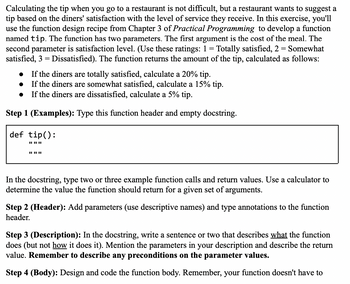
Computer Networking: A Top-Down Approach (7th Edition)
7th Edition
ISBN: 9780133594140
Author: James Kurose, Keith Ross
Publisher: PEARSON
expand_more
expand_more
format_list_bulleted
Question
Please do the exercise! I want to confirm my work Thank you very much

Transcribed Image Text:handle invalid function call arguments, as long as you've used preconditions to document your
assumptions about the parameter values.
Save the code, then click Run. Correct any syntax errors.
Step 5 (Test): Use the Python shell to test tip. If necessary, edit the function body and retest
until the function passes all the tests.

Transcribed Image Text:Calculating the tip when you go to a restaurant is not difficult, but a restaurant wants to suggest a
tip based on the diners' satisfaction with the level of service they receive. In this exercise, you'll
use the function design recipe from Chapter 3 of Practical Programming to develop a function
named tip. The function has two parameters. The first argument is the cost of the meal. The
second parameter is satisfaction level. (Use these ratings: 1 = Totally satisfied, 2 = Somewhat
satisfied, 3 = Dissatisfied). The function returns the amount of the tip, calculated as follows:
If the diners are totally satisfied, calculate a 20% tip.
If the diners are somewhat satisfied, calculate a 15% tip.
If the diners are dissatisfied, calculate a 5% tip.
Step 1 (Examples): Type this function header and empty docstring.
def tip():
||||||
|| || ||
In the docstring, type two or three example function calls and return values. Use a calculator to
determine the value the function should return for a given set of arguments.
Step 2 (Header): Add parameters (use descriptive names) and type annotations to the function
header.
Step 3 (Description): In the docstring, write a sentence or two that describes what the function
does (but not how it does it). Mention the parameters in your description and describe the return
value. Remember to describe any preconditions on the parameter values.
Step 4 (Body): Design and code the function body. Remember, your function doesn't have to
Expert Solution
This question has been solved!
Explore an expertly crafted, step-by-step solution for a thorough understanding of key concepts.
This is a popular solution
Trending nowThis is a popular solution!
Step by stepSolved in 3 steps with 1 images

Knowledge Booster
Similar questions
- It would be helpful to me if you could provide me some concrete examples of digital piracy and intellectual property violation.arrow_forwardHi - Can you help me with this procedures? Thanks!! Set up a Github account (you may use your own name or a pseudonym). Create a repo called datasciencecoursera Copy and paste the link to your GitHub account (or a direct link to your datasciencecoursera repo)arrow_forwardWhat conclusions or suggestions can we make about the crime of committing crimes online as a result of this?arrow_forward
- Please limit your comments to three or four. What does it mean to prioritize human rights in development, science, and technology policy?arrow_forwardConsider all of the information that is currently saved on the hard disc of your computer right now. Do you need to have a quick look at confidential information that's saved on your computer? What are some of the possible implications that might arise as a result of this information being lost or stolen? What preventative measures can you take to keep your electrical gadget safe?arrow_forwardCould you please explain the concept of privacy? How well do you understand the need of keeping your own information private? Create a list of five different approaches.arrow_forward
- Unfortunately, the proliferation of the internet has led to a rise in the crime of stealing someone else's identity. For your homework, please detail the various strategies identity thieves may use and the precautions that, in your view, should be taken to counteract them.arrow_forwardWhat are some of the many ideas that have been proposed on the occurrence of cybercrime? In response to your inquiry, I was wondering if you could kindly supply some references.arrow_forwardI would be able to discern the difference between legal and illegal digital piracy if you gave me some concrete instances of both.arrow_forward
arrow_back_ios
arrow_forward_ios
Recommended textbooks for you
 Computer Networking: A Top-Down Approach (7th Edi...Computer EngineeringISBN:9780133594140Author:James Kurose, Keith RossPublisher:PEARSON
Computer Networking: A Top-Down Approach (7th Edi...Computer EngineeringISBN:9780133594140Author:James Kurose, Keith RossPublisher:PEARSON Computer Organization and Design MIPS Edition, Fi...Computer EngineeringISBN:9780124077263Author:David A. Patterson, John L. HennessyPublisher:Elsevier Science
Computer Organization and Design MIPS Edition, Fi...Computer EngineeringISBN:9780124077263Author:David A. Patterson, John L. HennessyPublisher:Elsevier Science Network+ Guide to Networks (MindTap Course List)Computer EngineeringISBN:9781337569330Author:Jill West, Tamara Dean, Jean AndrewsPublisher:Cengage Learning
Network+ Guide to Networks (MindTap Course List)Computer EngineeringISBN:9781337569330Author:Jill West, Tamara Dean, Jean AndrewsPublisher:Cengage Learning Concepts of Database ManagementComputer EngineeringISBN:9781337093422Author:Joy L. Starks, Philip J. Pratt, Mary Z. LastPublisher:Cengage Learning
Concepts of Database ManagementComputer EngineeringISBN:9781337093422Author:Joy L. Starks, Philip J. Pratt, Mary Z. LastPublisher:Cengage Learning Prelude to ProgrammingComputer EngineeringISBN:9780133750423Author:VENIT, StewartPublisher:Pearson Education
Prelude to ProgrammingComputer EngineeringISBN:9780133750423Author:VENIT, StewartPublisher:Pearson Education Sc Business Data Communications and Networking, T...Computer EngineeringISBN:9781119368830Author:FITZGERALDPublisher:WILEY
Sc Business Data Communications and Networking, T...Computer EngineeringISBN:9781119368830Author:FITZGERALDPublisher:WILEY

Computer Networking: A Top-Down Approach (7th Edi...
Computer Engineering
ISBN:9780133594140
Author:James Kurose, Keith Ross
Publisher:PEARSON

Computer Organization and Design MIPS Edition, Fi...
Computer Engineering
ISBN:9780124077263
Author:David A. Patterson, John L. Hennessy
Publisher:Elsevier Science

Network+ Guide to Networks (MindTap Course List)
Computer Engineering
ISBN:9781337569330
Author:Jill West, Tamara Dean, Jean Andrews
Publisher:Cengage Learning

Concepts of Database Management
Computer Engineering
ISBN:9781337093422
Author:Joy L. Starks, Philip J. Pratt, Mary Z. Last
Publisher:Cengage Learning

Prelude to Programming
Computer Engineering
ISBN:9780133750423
Author:VENIT, Stewart
Publisher:Pearson Education

Sc Business Data Communications and Networking, T...
Computer Engineering
ISBN:9781119368830
Author:FITZGERALD
Publisher:WILEY